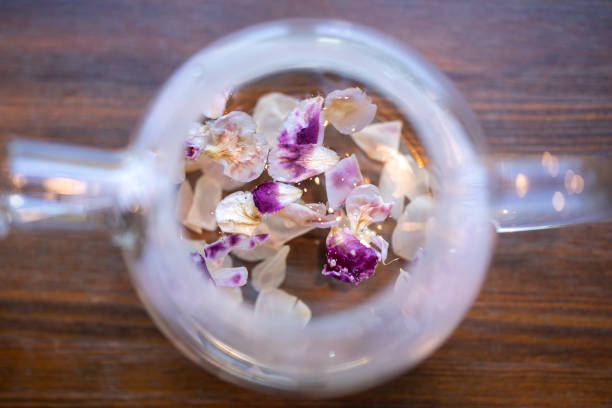Flower tea, also known as floral tea or blooming tea, is a delightful infusion that captivates the senses with its vibrant colors, fragrant aromas, and exquisite flavors. This traditional beverage, enjoyed for centuries in various cultures, is not only a treat for the palate but also offers numerous health benefits. In this article, we will explore the origins, preparation methods, health advantages, and popular varieties of flower tea, as well as some tips for enjoying this enchanting drink to its fullest.
Origins and History
The practice of infusing flowers in hot water dates back thousands of years, with roots in ancient China. Initially, flower tea was part of traditional Chinese medicine, where it was used to treat various ailments and promote overall well-being. The art of making flower tea evolved over time, becoming a refined practice in the Chinese imperial courts. Today, flower tea is enjoyed worldwide, with different cultures adding their unique twists to this aromatic beverage.
Preparation Methods
Preparing flower tea is an art form that requires careful selection of flowers, proper drying techniques, and a delicate brewing process. Here’s a step-by-step guide to making a perfect cup of flower tea:
- Selecting Flowers: Choose fresh, edible flowers that are free from pesticides and other chemicals. Popular choices include jasmine, chrysanthemum, rose, hibiscus, lavender, and osmanthus. Each flower offers a distinct flavor and aroma.
- Drying Flowers: Flowers can be dried using various methods, such as air drying, sun drying, or using a dehydrator. The goal is to remove moisture while preserving the flowers’ natural colors and fragrances.
- Brewing: Place a handful of dried flowers in a teapot or cup. Pour hot water (about 90°C or 194°F) over the flowers and let them steep for 3-5 minutes. The longer the steeping time, the stronger the flavor. Strain the tea and serve.
- Enhancements: Flower tea can be enjoyed on its own or enhanced with additional ingredients like honey, lemon, or other herbs and spices to complement the floral notes.
Health Benefits
Flower tea is not only a sensory delight but also a treasure trove of health benefits. Different flowers offer unique medicinal properties, contributing to overall health and well-being.
Antioxidant Properties
Many flowers used in tea, such as jasmine and hibiscus, are rich in antioxidants. These compounds help combat oxidative stress, reduce inflammation, and protect against chronic diseases like heart disease and cancer.
Stress Relief and Relaxation
Flowers like lavender and chamomile are well-known for their calming effects. Lavender tea can help reduce anxiety and improve sleep quality, while chamomile tea is often used to soothe digestive issues and promote relaxation.
Immune System Support
Flowers like echinacea and elderflower have been traditionally used to boost the immune system. Echinacea tea is particularly popular during cold and flu season for its potential to reduce the duration and severity of symptoms.
Digestive Health
Peppermint and ginger flowers are commonly used to aid digestion. Peppermint tea can relieve symptoms of indigestion and bloating, while ginger tea helps with nausea and promotes healthy digestion.
Popular Varieties
The world of ชาดอกไม้ is vast and varied, with each type offering a unique experience. Here are some popular varieties:
Jasmine Tea
Jasmine tea is a classic floral tea made by infusing green tea leaves with jasmine blossoms. The result is a fragrant and refreshing tea with a delicate floral aroma and a slightly sweet taste. It is often enjoyed as an afternoon tea or paired with Asian cuisine.
Chrysanthemum Tea
Chrysanthemum tea is a traditional Chinese tea made from dried chrysanthemum flowers. It has a mild, slightly sweet flavor and is often consumed for its cooling properties, making it a popular choice in hot climates. Chrysanthemum tea is also believed to help with eye health and detoxification.
Rose Tea
Rose tea, made from dried rose petals, is known for its romantic aroma and soothing properties. It has a light, floral flavor and is often used to promote relaxation, improve skin health, and alleviate menstrual discomfort.
Hibiscus Tea
Hibiscus tea, made from the vibrant red petals of the hibiscus flower, is tart and refreshing. It is rich in vitamin C and antioxidants, making it a popular choice for boosting the immune system and supporting cardiovascular health. Hibiscus tea can be enjoyed hot or cold and is often sweetened to balance its natural tartness.
Lavender Tea
Lavender tea, made from dried lavender flowers, is renowned for its calming and stress-relieving properties. It has a mild, floral flavor with a hint of sweetness and is often consumed before bedtime to promote restful sleep.
Tips for Enjoying Flower Tea
To fully appreciate the beauty and benefits of flower tea, consider these tips:
- Quality Matters: Use high-quality, organic flowers to ensure the best flavor and health benefits. Avoid flowers that have been treated with pesticides or other chemicals.
- Experiment with Blends: Don’t be afraid to mix different flowers and herbs to create your unique blends. Combining flowers like rose and chamomile or lavender and mint can yield delightful results.
- Mindful Brewing: Pay attention to the brewing time and water temperature to avoid over-extracting the flowers, which can result in a bitter taste.
- Presentation: Serve flower tea in a clear glass teapot or cup to fully appreciate the visual beauty of the blooming flowers. Adding a slice of lemon or a sprig of mint can enhance the presentation.
- Relax and Enjoy: Take the time to savor the aroma and flavor of flower tea. Create a calming environment, perhaps with soft music or a good book, to enhance the experience.
Conclusion
Flower tea is more than just a beverage; it’s an experience that engages all the senses. From the delicate preparation process to the myriad health benefits and the sheer pleasure of sipping a beautifully fragrant tea, flower tea offers a moment of tranquility in our busy lives. Whether you’re a seasoned tea enthusiast or new to the world of floral infusions, there’s always something new to discover in the blossoming world of flower tea.

